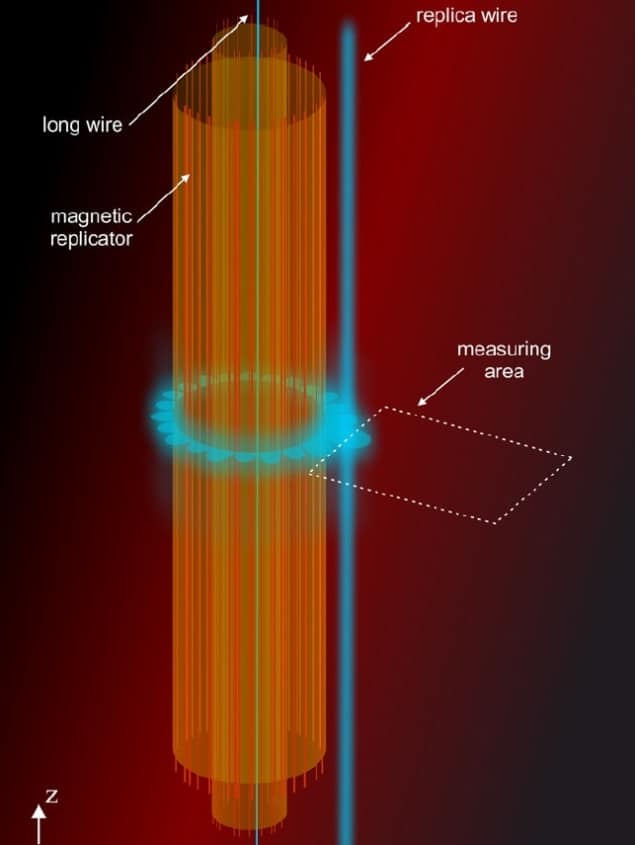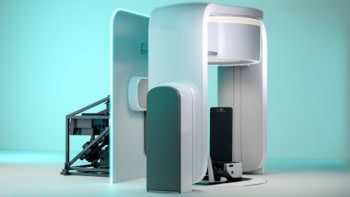
Physicists in the UK and Spain claim that they have found a way to generate and manipulate magnetic fields at a distance. This opens up the possibility of projecting magnetic fields into inaccessible spaces and enables the remote cancellation of magnetic sources, the researchers say. One application of this technique could be improving the control of magnetic microbots and nanoparticles within the human body, for medical applications such as drug delivery and magnetic hyperthermia therapies.
In recent years, metamaterials have enabled scientists to manipulate magnetic fields in unexpected ways, such as creating a magnetic cloak that can make an object magnetically undetectable and magnetic wormholes, which transport a magnetic field from one point in space to another.
In this latest work, published in Physical Review Letters, Rosa Mach-Batlle at the Universitat Autònoma de Barcelona and her colleagues wanted to see if they could generate a magnetic field that appears in free space, at a distance from its source.
Mach-Batlle tells Physics World that theory showed that to achieve this, they would need a magnetic material with negative permeability. Magnetic permeability is the ability of a material to acquire magnetization in magnetic fields. But there are no natural materials with negative permeability values.
Previously, the researchers had shown that a metamaterial with negative-permeability can be created by applying a precise arrangements of currents to the material. This time, their theory showed that a long cylindrical tube with a magnetic permeability of −1 would act as a lens for electromagnetic waves. If this cylinder was then placed around a magnetic source, the distribution of the magnetic field outside this shell would appear as if it had been created by another magnetic source – a kind of magnetic illusion – at a distance from the cylinder.
To create the metamaterial, the physicists used a 400 mm-long cylinder with a 40 mm radius. With an arrangement of 20 wires, they controlled the surface current densities on its internal and external surfaces. A wire running through the centre of the tube generated the magnetic field.

The researchers showed that with this set up they could create magnetic sources at a distance from the cylinder. They also demonstrated that the metamaterial can be used to remotely cancel another magnetic field, by setting up a wire with a current flowing through it at the point where they expected the projected magnetic field to appear. The magnetic fields generated by the wire and the metamaterial cancelled each other out. This technique could be used, the team say, to remotely cancel magnetic sources in inaccessible spaces, such as within a wall or inside a human body.
Mach-Batlle tells Physics World that it is worth noting that the magnetic field is not cancelled in all of the space. “There is a cylindrical region between our metamaterial and the source that we cancel,” she explains. “In this small region, the field is not cancelled, but in the rest of the space we would be cancelling the field of the source that we chose to cancel.”
The main practical application for this technique, Mach-Batlle believes, is not in cancelling magnetic sources, but in being able to create the illusion of a magnetic field at a distance inside inaccessible spaces. This could have important implications in medicine, as it could be possible to project a magnetic source inside the body.
If you create the illusion of a magnetic source inside the body, Mach-Batlle explains, you get a much stronger field compared with having the sources outside of the body. This could be useful for the control and manipulation of nanoparticles for drug delivery and nanorobots that could be used for various types of surgery.
“Also, in neuroscience, we think that it can have implications for transcranial magnetic simulation,” Mach-Batlle says. This technique for generating electric current at a specific area of the brain is an evolving area of research that has shown diagnostic and therapeutic potential in a number of neurological diseases and mental health conditions.



